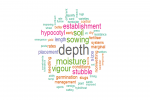Key points
- Tim Whitehead’s barley won a GRDC Hyper Yielding Crops initiative award
- The dryland crop was the highest yielding in Victoria
- It returned 74.43 per cent of its potential yield, which had been estimated at 10.48t/ha
- The Hyper Yielding Crops initiative, led by Field Applied Research Australia, spans the high-rainfall areas of Victoria, South Australia, Tasmania, southern New South Wales and Western Australia
- Its focus is helping growers in those areas close the gap between actual and estimated cereal grain yield potential
When Tim Whitehead was told his barley had won a Hyper Yielding Crops award, he suggested the organisers run the numbers again. He attributes the win to luck, paddock history and raised beds
One of mainland Australia’s southernmost barley crops has proved to be one of the best yielding, taking out an award in the annual GRDC Hyper Yielding Crops (HYC) initiative.
Tim Whitehead, who farms with his wife, Belinda, and father, Tim senior, at Spring Creek, near Minhamite in south-western Victoria, harvested 7.8 tonnes per hectare of RGT Planet barley in December 2023.
It was the highest yielding in Victoria; nationally, the paddock ranked sixth for yield behind crops from Tasmania and South Australia.
Photos of the crop taken several weeks before harvest show it standing tall with heavy heads, which were measured at 682 per square metre and averaged 29 grains each.
When he was told of the result, a surprised Tim suggested they should run the numbers again.
“We were not involved in it to try and be a winner,” he says. “We just wanted more information and to be involved with the farming group running it.”
Tim attributes the unexpected result to a combination of luck, paddock history and their use of three-metre raised beds to improve drainage, trafficability and grow denser crops that can outcompete weeds.
The 120ha paddock was so wet in 2022 the canola crop fell over, so he sprayed it out, put sheep into it and then sowed a summer crop of karaka leafy turnips for grazing.
After several extremely wet years, the well-developed tap roots helped drain the subsoil.
We direct drilled the barley into the summer crop stubble and it never looked back. It took off. It nearly got too wet, but it was on bedded country, so that helped as well.
“It didn’t use up all the phosphorus that we put in,” Tim says. “Because we’d sown two crops, there was a fair bank under it, and then we sowed with 100 kilos of MAP again. So, I think we probably increased the phosphorus levels to a point where the barley just thrived.”
The award-winning crop was sown on 10 May 2023 at a seeding rate of 100kg/ha.
After three years of above-average rainfall, wet conditions continued from February to June, when 98 millimetres – almost double the average – was recorded.
The pattern reversed in July, which was followed by another four months of below-average rain.
Warmer-than-average temperatures in September shortened flowering, while average temperatures during October and November were beneficial for grain fill.
“In 2023, we got very wet and then had a terribly dry finish,” Tim says. “That’s why I think the barley probably was a bit of a standout. It just finishes well in the dry.”
The HYC initiative, led by Field Applied Research Australia, spans the high-rainfall areas of Victoria, South Australia, Tasmania, southern New South Wales and Western Australia.
Its focus is to help growers in those areas close the gap between actual and estimated cereal grain yield potential.
GroundCoverTM story: Brainstorming with other growers a path to progress

























































